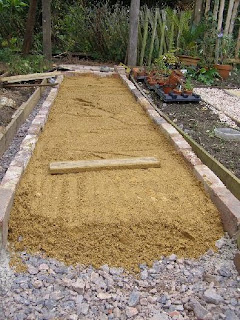Step 5: start mixing your mortar. I went for a 1:4 mix of cement to sand which seemed to work pretty well. You slosh a bit of water in and then squirt some washing up liquid after it - this keeps the mortar elastic - before using the oldest spade you have to mix it up until it's the sloppy side of solid - about the texture of blancmange. This is the best way of ruining gardening tools I know.
Step 6: Use the mortar to set your edging bricks. At this point I thought I'd better start taking some pictures of my somewhat erratic progress.
 This bit isn't quite as bad as it seems: I used pegs and string to mark the outer edge of the path so I had a line to follow and then it was a matter of using a rubber mallet to knock the bricks in place.
This bit isn't quite as bad as it seems: I used pegs and string to mark the outer edge of the path so I had a line to follow and then it was a matter of using a rubber mallet to knock the bricks in place.
Step 7: go and do something else for a day while it all dries.
Step 8: it's time to play with the sand you ordered, if the neighbour's kids haven't got there first. A 2" layer inside the brick edging, if you please.
Step 9: level the sand and dry-lay the bricks, making sure they're level in every direction - I put a gentle camber on mine from one side to the other to drain the water off.
At this point Joe Swift produced a natty little bit of wood, with the profile of a brick cut out of each side so it "hung" on the sides of the path and acted as a template to smoothe your sand level.
I thought this looked like a good idea, so gave it a go. Sadly, I quickly realised the catch: it does assume that all your bricks are identical. In some misguided attempt to be a bit more environmentally sound we'd bought our bricks reclaimed at an auction, so they were every possible size, shape and thickness you can imagine and I had to lay them all individually, using my little rubber mallet and taking Bloomin' Ages.

Still, it's starting to take shape and look ever so slightly like a proper path by now.
Step 10: Mix some more 1:4 mortar but don't put the water in this time. Make sure it's not raining, or even a bit damp, and use one of those little pointing trowels to feed the dry mix into the gaps. Then follow up with a stiff brush so there's not even a little bit left on the surface of the bricks (where it will set in a grey and depressing mat of concrete). This is why it's essential your bricks should be dry before you start this bit. By the way, the grey and depressing bits on the bricks above were already there - see reclaimed bricks comment earlier.
By the way, the grey and depressing bits on the bricks above were already there - see reclaimed bricks comment earlier.
Now, I was lucky and it rained the night after I did this so all the mortar was beautifully watered in and set almost straight away. But if it doesn't rain, you'll have to do this yourself with a hose set on sprinkler - don't blast water at it all or you'll wash out all the mortar and have to start again.
By the way, being a very amateur bricky, I cheated.

I have three holes in my path: here, where the four arms of the cross meet (there are two little side-paths off to my shed and my greenhouse - oh, no, I'm not over-ambitious, oooooh no) and at each end, where the squares I made under the gates in and out were, ahem, not exactly square.
One of the many things I discovered through making this path is the reason why brick paths are always an odd number of bricks across. The width of my path, for reasons lost in the mists of history, is six bricks across for the main bit and four across for the side paths. This doesn't work, and my maths isn't up to working out why. So I just fudged it. A little concrete and a few pretty pebbles should fill in the hole nicely.
Doncha just love amateur DIY enthusiasts? What can I say - I make mistakes so you don't have to. Still, I got a pretty good new brick path, and I learned an awful lot of things - chief among which was that It's Never as Easy as it Looks On TV.







3 comments:
Many of the subject they cover on tv are never as easy in real life. But that said, you did a great job. Can't wait to see the finished project.
Jen
They don't show you Where It Went WRONG do they?
Project like this always have a learning curve. I think you did great for a first-timer.
Post a Comment